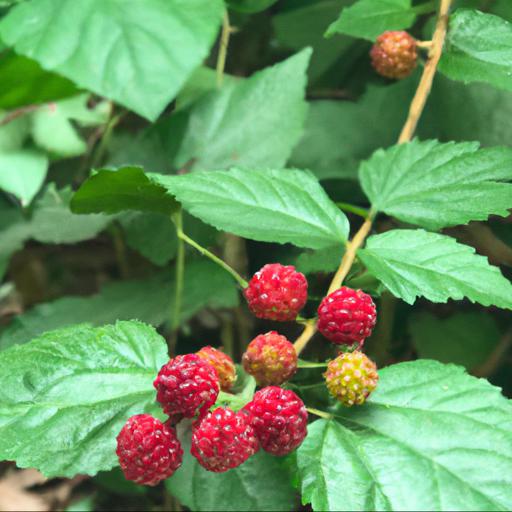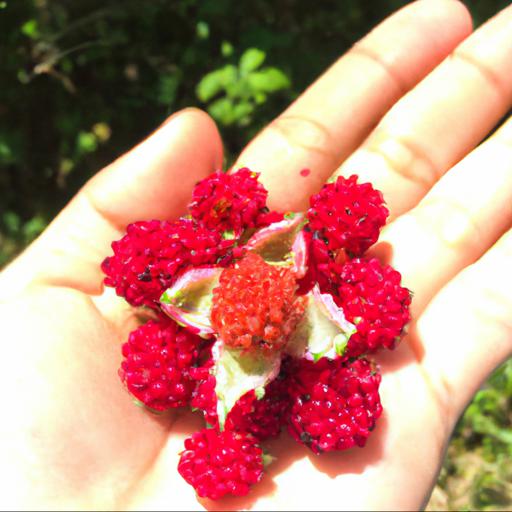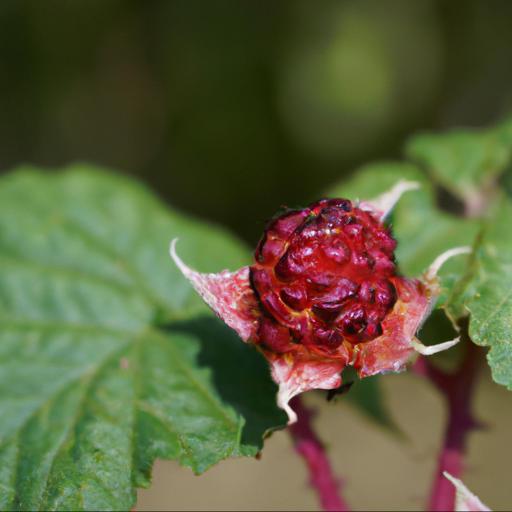Rubus x loganobaccus, commonly known as Loganberry, is a hybrid of the blackberry and raspberry. It is a vigorous, thorny, trailing shrub and produces large, juicy, dark red berries.
Loganberry is a popular berry in the United States and is widely used in jams, jellies, pies and other desserts. It is also a great source of antioxidants and vitamins. Loganberry has a distinct flavor that sets it apart from other berries.
Its sweet and tart taste is unique and is sure to add a special touch to any dish. Loganberry is a great addition to any garden, and it is easy to grow and care for.
With its delicious flavor and health benefits, Loganberry is a must-have for any berry lover.
Characteristics of rubus x loganobaccus

Rubus x loganobaccus, sometimes called loganberry, is an attractive and often underused evergreen shrub grown for its edible fruit and vivid flowering display. The name loganberry has its roots in the Oregon nurseryman, James Harvey Logan, who discovered the hybrid blackberry-raspberry hybrid in the 19th century.
It is widely grown in gardens, capturing the imagination of amateur and professional gardeners alike. The shrub itself is a vigorous grower, typically reaching a height of 2-5m, boasting arching stems and thorns.
In season, the foliage is dappled with tiny white or yellow flowers, small clusters of which can be found at the leaf axils. After flowering in summer, red drupelets of raspberry-blackberry hybrid fruits appear, usually turning a deep burgundy as they ripen. The sweet, juicy and aromatic fruits are suitable for making jams and wines, as well as for eating raw.
Especially when grown in the open, Rubus x loganobaccus requires regular water to flourish and provides best yields of fruit when planted in fertile soil. The addition of well rotted manure or compost during planting, and again as a top dressing each spring, helps to keep the shrub healthy and productive.
Keeping the shrub in tidy shape is a good way to prevent pests and diseases, as well as maintain its attractive upright habit. Loganberry is ideal for mild UK climates, although places with colder weather should take precautions in the wintertime such as providing heavy mulching or covering with garden fabric. In conclusion, Rubus x loganobaccus is a delightful shrub to have in the garden, whether you are a beginner or a seasoned gardener.
As well as bringing plenty of beauty and colour to your outdoor spaces with its vibrant foliage, flowers and fruit, it can also provide tasty jams, jellies and wines. With a bit of extra care, this hardy and rewarding shrub is sure to reward its growers with a great dramatic display.
Growing and caring for rubus x loganobaccus

Growing and caring for Rubus x loganobaccus is a must for any green-fingered UK gardener. Also known as the Loganberry, this hybrid berry-bush is renowned for its sweet-sour fruit, which can be enjoyed either fresh from the bush or from preserves. With the correct care and cultivation, it is possible to yield a large amount of delicious Loganberry fruit in each season and ensure that this unique and tasty addition to any garden is ready for picking year after year.
When growing Rubus x Loganobaccus, the first step is to ensure that all of the necessary components, such as soil, sunlight, and water, are befitting for the Loganberry. In terms of soil, the optimal conditions are a mix of both sand and loam, with a pH range between
5 and
The bush should be planted in an area where it receives at least six to eight hours of sunlight daily. Regular, steady watering is especially important when the bush is in bloom and throughout the ripening stages of the fruit, which usually occurs during the summer months in the UK. To ensure a harvest of sweet, tart Loganberries, pruning and training should be done at the start of the season.
Pruning helps the bush to by removing all dead and damaged branches, thinning out congested growth, and managing the overall height, shape and health of the Bush. This can be done with the help of a simple pair of garden shears. Additionally, if left unchecked, the Loganberry’s slim branches and light canes can become easily weighed down under the weight of the fruit, dictating the need for a light-weight trellis or support system to help keep the bush above ground when the berries begin to develop.
Overall, a well cultivated, productive Loganberry bush is not only a spectacular sight in any garden, but a reliable and ongoing source of delicious summer fruit. With the right knowledge and attention, UK gardeners can make the most of their Rubus x loganobaccus and reap the rewards of having a bush full of sweetly tart Loganberries and the perfect accompaniment to any salads, jams or desserts.
Uses of rubus x loganobaccus

Rubus x loganobaccus, often referred to as the evergreen loganberry, is an excellent choice for UK gardeners who want a low maintenance fruit-bearing berry bush. This hybrid variety is the result of a cross between a raspberry and a blackberry and exhibits characteristics of both these popular plants. The hardy evergreen loganberry is resistant to both drought and wet conditions and can flourish in a variety of soils, making it a reliable choice of berry bush.
It produces a delicious sweet-tart fruit with a tangy flavour that is often used in jams and pies. Because of its deep root system, it will tolerate a variety of conditions, even standing water.
In addition to its usefulness as a fruit-bearing bush, the loganberry is immensely popular as a landscaping plant. It can be used as a hedge thanks to its denseness and can be quite aesthetically pleasing when pruned to shape. Its evergreen foliage means it always looks lush, even in the winter and can provide your garden with year-round colour and beauty.
The fruit is rich in dietary fibre and antioxidants, making it a healthy addition to your fruit bowl. If you are looking for a hardy, low maintenance berry bush for your UK garden, look no further than the evergreen loganberry (Rubus x loganobaccus).
With its sweet fruit and easy-to-care-for foliage, it is a great choice for gardeners of any skill level.
Conclusion
Rubus x loganobaccus, also known as Loganberry, is a hybrid berry of the Rubus genus. It is a cross between the blackberry and the raspberry, and is a popular fruit in home gardens.
It has a sweet-tart flavour and is used to make jams and jellies. Loganberry is high in Vitamin C, potassium and dietary fibre, making it a healthy addition to any diet. It is also known for its antioxidant properties and can help reduce the risk of certain diseases.
FAQ
What is the scientific name of Rubus x loganobaccus?
The scientific name of Rubus x loganobaccus is Rubus × loganobaccus.
What are the characteristics of Rubus x loganobaccus?
Rubus x loganobaccus is a hybrid species of raspberry that is a cross between Rubus loganobaccus and Rubus idaeus. It is a deciduous shrub with an upright, arching habit and has long, arching canes that can reach up to 3 meters in height. The leaves are compound, with three to five leaflets, and are dark green in color. The flowers are white and have five petals, and the fruit is a large, dark red raspberry.
Where is Rubus x loganobaccus found?
Rubus x loganobaccus is found in the eastern United States, from Maine to Florida, and west to Michigan and Louisiana.
What is the growth habit of Rubus x loganobaccus?
Rubus x loganobaccus is a deciduous, perennial shrub with a vining growth habit. It has arching stems that can reach up to 8 feet in length.
How is Rubus x loganobaccus propagated?
Rubus x loganobaccus is propagated by softwood cuttings, layering, or division.
What are the uses of Rubus x loganobaccus?
The uses of Rubus x loganobaccus include edible fruits, ornamental landscaping, and medicinal purposes. The fruits can be eaten raw or used to make jams, jellies, and syrups. The leaves and stems can be used to make tea and other herbal remedies. The plant is also used for ornamental landscaping due to its attractive foliage and flowers.

